Proofs that the Papacy is the Antichrist = Part 2
http://www.historicism.com/Guinness/Romanism/Lecture3.htm
[[[[[[[[[Sits in the Temple of God claiming to be God]]]]]]
There are several features in this portrait which I must ask you to specially notice. Observe the place occupied by the man of sin ù the "temple" or house of God. This is not, and cannot be, any Jewish temple. Paul, who uses this expression in his prophetic portrait of Romanism, employs it both in Corinthians and Ephesians with reference to the Christian Church. In the second Epistle to the Corinthians, writing to Gentile Christians, he says, "Ye are the temple of the living God; as God hath said, I will dwell in them, and walk in them." In Ephesians he calls the Church "a holy temple," a "habitation of God through the Spirit"; and he would never have applied it to the Jewish temple, which, with all other Jewish things, he regarded as mere shadows of Christian realities. To Paul emphatically the temple of God was the Church of Christ. This is the temple in which his prophetic eye saw the man of sin seated. It is no question of his bodily location in any structure of wood and stone, but of something far higher. The temple of God is that "spiritual house" in which He dwells. It is built of "living stones," of true believers. It is here that the man of sin was to usurp the place of God. This is the "mystery," the dread danger, the deadly evil, predicted by the Apostle. It is no person in a temple of stone, but a power in the Christian Church.
[[[[[[[[[MAN OF SIN]]]]]]]]]][[[Temple of God]]]]]]]
Observe next the character of the man of sin. He is at once an imitation of Christ, and a contrast to Him. He occupies His position, but is totally unlike Him, and opposed to Him. He has usurped His place and His prerogatives; but, so far from truly representing Him, he represents His great enemy. As Christ acts for God, so the man of sin acts for Satan, who indeed produces him for this very purpose. His coming is "after the working of Satan." Christ and he are antagonistic powers: the power of light, and the power of darkness; the Majesty of heaven, and the might of hell. And as the Son of God humbled Himself, so the "man of sin" exalts himself. There is infinite self- abasement in the one, the Divine nature stooping to humanity; and infinite self-exaltation in the other, the human and satanic assuming to be Divine. Observe here that it is not asserted that the man of sin will say that he is God, but that he will show himself as such. The words are, "He as God sitteth in the temple of God, showing himself that he is God" or is Divine, or a Divine being. (apodelknuJnta eanton oti esti Qeov) There is no article here before the name God. The expression indicates that the man of sin would show himself by acts and professions to be possessed of superhuman and Divine dignity, authority, and power.
Observe the position of the man of sin. Notice the word kaqisai, "sitteth," and connect with it kaqedra, a seat, a word which occurs three times in the New Testament. It is used twice with reference to the seats in the temple of those who sold doves, who turned the house of God into a house of merchandise and den of thieves; and once in the sentence, "the Pharisees sit in Moses’ seat." From kaqedra comes "cathedral," "the bishop’s seat," and also the expression ex cathedra, or from his seat, officially. There, in that exalted cathedral position, and claiming to represent God, the man of sin was to act and abide as the pretended vicar, but real antagonist, of Christ, undermining His authority, abolishing His laws, and oppressing His people. Observe the words, "who opposeth." It is possible effectually to oppose another without being his avowed antagonist; so the professions of the predicted power might be friendly, while his actions would be those of an opponent of the gospel of Christ.
^^^^^^^Thoughts on this(My (Chris Lucas) note: I ask you, what is more of a lying wonder than this? To appear to the world as Christ's chief servant (vicar of Christ) but be its ultimate antagonist.]]]]]]]]]
We have said that the principles which were ultimately to produce the man of sin had already begun to operate in Paul’s own day. His words are, "The mystery of iniquity doth already work"; and these principles would continue to work until the full development of the apostasy, and its final destruction at the Second Advent: that is, throughout the eighteen Christian centuries.
The sphere of their operation therefore cannot be the Jewish temple, which was destroyed in the first century, but must needs be the professing Christian Church.
[[[[[[[[[THE RESTRAINER]]]]]]]]]]]]]]]]]]]]]]]]
An important point in the prophecy is the existence in apostolic times of a certain restraining power, withholding while it lasted the manifestation of the man of sin. Paul, for good reasons, speaks of it in guarded language, as "he who letteth," or "that which hinders." What it was Paul knew, and the Thessalonians knew from him: "Remember ye not, that, when I was yet with you, I told you?" The early Church - from whom alone we can learn what Paul told them by word of mouth, but refrained from committing to writing has left it on record that the Apostle had told them that this hindering power was the dominion of the Roman Caesars; that while they continued to reign at Rome, the development of the predicted power of evil was impossible. Hence it would seem that ROME would be the seat of the man of sin. During the continuance of the Roman empire there was no opportunity for him to rise; he would only be manifested on its fall. While the Caesars reigned he could not appear, but when they passed away he would succeed them.
Notice particularly that, just as the expression, "he that letteth," comprehends the line of succession of the Caesars, so the expression, "he that sitteth," may well comprehend an analogous line or succession of rulers. Both expressions refer to dynasties, and not to individuals.
The distinctive names given by Paul to the great head of the apostasy are expressive of his character. They are the "man of sin," the "son of perdition," and "that wicked" (o anomov, the lawless one). First, it was to be to an extraordinary extent sinful itself, and the occasion of sin in others; secondly, it would be like Judas, and share his doom; and, thirdly, it would set at defiance all laws, whether human or Divine. It would be inspired by Satan, and, on account of its evil character and actions, it would be doomed to destruction; it would eventually "go to its own place" ù the bottomless pit, from whence it emanated. Its doom was to fall in two stages: the Lord Himself would consume it by the spirit of His mouth, and destroy it by the brightness of His epiphany, or advent in power and glory. There would be first a consumption, then a destruction. It would continue until the second coming of Christ a statement which, as you will observe, involves the Lord’s return before the millennium, since there can be no millennium under the reign of the man of sin, nor prior to his utter destruction.
Let us now compare this portrait of the man of sin drawn by the Apostle Paul with the portrait of the self-exalting power foretold by Daniel, which we studied last week. The comparison will demonstrate their identity.
1. Both are Roman. The self-exalting horn or head represented by Daniel is Roman; it belongs to the fourth or Roman empire. So also does Paul ‘s man of sin, for the imperial government seated at Rome needed to be removed in order to make way for its rise and dominion. It was to be the successor of the Caesars at Rome. They have the same geographical seat.
2. They have the same chronological point of origin: both arise on the fall of the old undivided empire of Rome. And they have he same chronological termination: Daniel’s little horn perishes at the coming of the Son of man in glory, and Paul’s man of sin is destroyed at the epiphany.
3. Both exalt themselves against God. Daniel mentions the proud words of the blasphemous little horn, and Paul the audacious deeds of the man of sin, showing himself as Divine.
4. Both begin as small, inconspicuous powers, and develop gradually to very great and influential ones.
5. Both claim to be teachers of men. Daniel’s little horn was to have eyes, as a bishop, or overseer (the meaning of the word bishop, episkopov, is overseer); and that he was to have a mouth, that is, he was to be a teacher; while Paul assigns to the man of sin ecclesiastical eminence, a proud position in the temple of God, or Christian Church.
6. Both are persecutors. Daniel describes the little horn as a persecutor wearing out the saints, and Paul speaks of the man of sin as "opposing," and calls him the "lawless one."
To sum up. The two have the same place Rome; the same period ù from the sixth century to the second coming of the Lord in glory; the same wicked character, the same lawlessness, the same self-exalting defiance of God, the same gradual growth from weakness to dominion, the same episcopal pretensions, the same persecuting character, the same twofold doom.
These resemblances are so important, so numerous, so comprehensive, and exact, as to prove beyond all question that the self-exalting, persecuting power predicted by Daniel and this man of sin foretold by Paul are one and the same power. Even Romanists admit this to be the case, and call the power thus doubly predicted the antichrist.
-
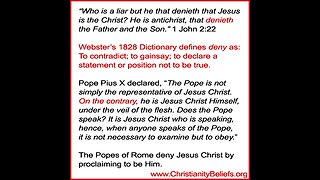 1:32:28
1:32:28
The Protestant View
1 year agoProofs that the Papacy is the Antichrist
3.17K12 -
 12:13
12:13
The Antichrist Empire Deconstruction
6 months agoThe Satanic Sermon On The Mount. Part 4. Blessed Are The Antichrist's Communist Slaves.
122 -
 9:01
9:01
Faith Truth Warnings ❤️ Glaube Wahrheit Warnungen
1 year agoSeptember 23, 2018 🇺🇸 JESUS SPEAKS about the Rapture, Tribulation, Donald Trump, Antichrist and Mark of the Beast
84 -
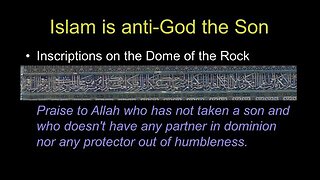 50:00
50:00
Prepare For The Apocalypse
1 year agoExplaining the antichrist from islamic point of view, parallels with Bible
3131 -
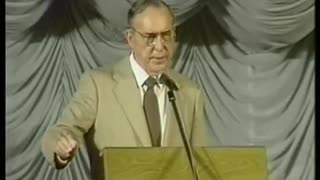 1:43:20
1:43:20
KatotohananTVTruthTV
1 year agoWorld Religion Alliance - Will The Antichrist Arise In Europe? - Where Are We In Biblical Prophecy 5
4582 -
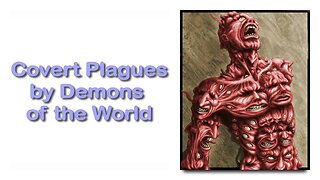 8:48
8:48
Jesus' Revelations thru Jakob Lorber English
11 months agoPossessed World... Covert Plagues by Demons of Worldliness ❤️ Jesus Christ explains Mark 5:12
145 -
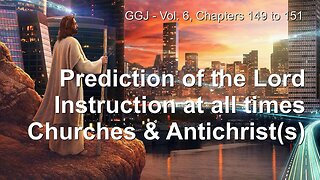 27:47
27:47
Jesus' Revelations thru Jakob Lorber English
1 year agoJesus ' Predictions regarding Churches & Antichrist /s ❤️ The Great Gospel of John revealed thru Jakob Lorber
3321 -
 8:10
8:10
The Antichrist Empire Deconstruction
6 months agoThe Satanic Sermon On The Mount. Part 3. True Miracle Working Power Vs the Devil’s Lies.
8271 -
 40:03
40:03
HandinHandwithGodTv
1 year agoPower To Triumph || Pastor Takes A Stand For Jesus & Could Not Be Burnt Alive || February 8, 2023
63 -
 21:38
21:38
Jesus Christ reveals thru Gottfried Mayerhofer
1 year agoOur Father... Jesus Christ explains ❤️ Secrets of Life revealed thru Gottfried Mayerhofer
94